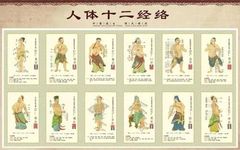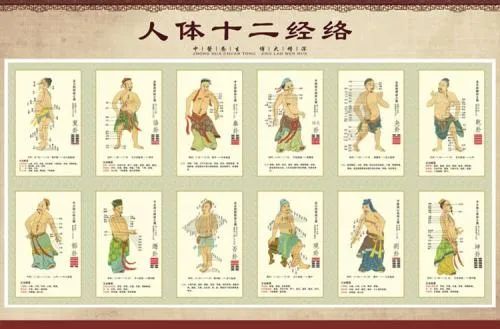
“
The Pathways of the Twelve Meridians
”
In the Huangdi Neijing, specifically in the Ling Shu: Reversal and Order of Fat and Thin, there is a passage that clearly describes the pathways of the twelve meridians in the human body:
“The three Yin meridians of the hands originate from the organs and travel to the hands; the three Yang meridians of the hands travel from the hands to the head; the three Yang meridians of the feet travel from the head to the feet; the three Yin meridians of the feet travel from the feet to the abdomen.”
In the original text, the term “organs” refers to the “chest.” This passage elucidates four rules regarding the pathways of the twelve meridians:
(1) The three Yin meridians of the hands originate from the chest and travel to the tips of the fingers, intersecting with the three Yang meridians of the hands;
The organs in the chest include the lungs, heart, and pericardium, corresponding to the three Yin meridians: the Taiyin Lung Meridian (Shou Taiyin Fei Jing), the Shaoyin Heart Meridian (Shou Shaoyin Xin Jing), and the Jueyin Pericardium Meridian (Shou Jueyin Xin Bao Jing). The three Yin meridians travel from the chest along the inner side of the arms to the tips of the fingers.
(2) The three Yang meridians of the hands all originate from the tips of the fingers and travel to the head and face, intersecting with the three Yang meridians of the feet;
The three Yang meridians of the hands travel from the tips of the fingers to the head and face. Since the three Yin meridians of the hands travel from the chest to the hands, they terminate at the tips of the fingers, connecting to the three Yang meridians of the hands, which are the Yangming Large Intestine Meridian (Shou Yangming Da Chang Jing), the Taiyang Small Intestine Meridian (Shou Taiyang Xiao Chang Jing), and the Shaoyang Sanjiao Meridian (Shou Shaoyang San Jiao Jing), all traveling along the outer side of the arms to the head and face, where they also terminate.
(3) The three Yang meridians of the feet originate from the head and face, traveling to the tips of the toes, intersecting with the three Yin meridians of the feet;
The three Yang meridians of the feet are the Yangming Stomach Meridian (Zu Yangming Wei Jing), the Shaoyang Gallbladder Meridian (Zu Shaoyang Dan Jing), and the Taiyang Bladder Meridian (Zu Taiyang Pang Guang Jing). These three Yang meridians travel from the head and face to the tips of the toes, where they also terminate, intersecting with the three Yin meridians of the feet.
(4) The three Yin meridians of the feet originate from the tips of the toes, traveling to the abdominal and thoracic cavities, intersecting with the three Yin meridians of the hands.
The three Yin meridians of the feet are the Taiyin Spleen Meridian (Zu Taiyin Pi Jing), the Jueyin Liver Meridian (Zu Jueyin Gan Jing), and the Shaoyin Kidney Meridian (Zu Shaoyin Shen Jing). These three Yin meridians travel from the feet to the abdomen, and finally ascend from the abdomen to the chest, where they intersect with the three Yin meridians of the hands.
Thus, a cycle is formed, described as “Yin and Yang interpenetrate, like a ring without end” (from Ling Shu: Ying Wei Sheng Hui).
We can summarize the rules of the pathways of the twelve meridians into four easy-to-remember phrases, which, combined with the diagram of the pathways of the twelve meridians below, will make it easier to remember.
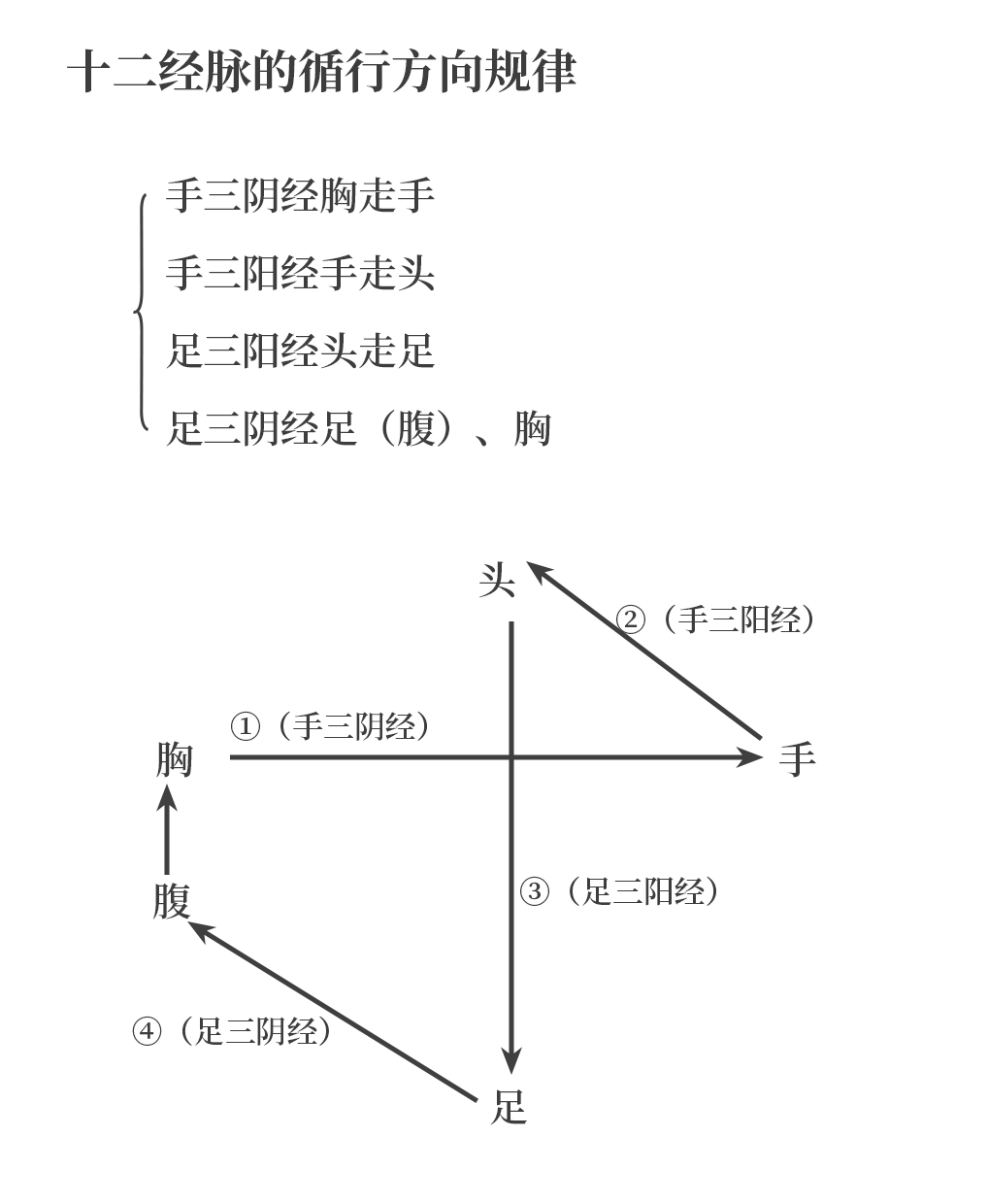
“
Rules of Interconnection of the Twelve Meridians
”
(1) Interconnection of Yin and Yang Meridians: This refers to the connection between Yin and Yang meridians at the limbs.
Specifically, the three Yin meridians of the hands connect at the tips of the fingers with the three Yang meridians of the hands, following the rule of interconnection between interior and exterior meridians; the three Yang and three Yin meridians of the feet connect at the tips of the toes, following the rule of interconnection between exterior and interior meridians.
For example, the Taiyin Lung Meridian (Shou Taiyin Fei Jing) connects with the Yangming Large Intestine Meridian (Shou Yangming Da Chang Jing) at the index finger; the Shaoyin Heart Meridian (Shou Shaoyin Xin Jing) connects with the Taiyang Small Intestine Meridian (Shou Taiyang Xiao Chang Jing) at the little finger; the Jueyin Pericardium Meridian (Shou Jueyin Xin Bao Jing) connects from the palm to the tip of the ring finger with the Shaoyang Sanjiao Meridian (Shou Shaoyang San Jiao Jing); the Yangming Stomach Meridian (Zu Yangming Wei Jing) connects from the dorsum of the foot to the big toe with the Taiyin Spleen Meridian (Zu Taiyin Pi Jing); the Taiyang Bladder Meridian (Zu Taiyang Pang Guang Jing) connects from the little toe diagonally across the sole to the Shaoyin Kidney Meridian (Zu Shaoyin Shen Jing); the Shaoyang Gallbladder Meridian (Zu Shaoyang Dan Jing) branches from the dorsum of the foot to the big toe, connecting with the Jueyin Liver Meridian (Zu Jueyin Gan Jing).
(2) Interconnection of Yang Meridians: This refers to the same-named hand and foot Yang meridians connecting at the head and face.
For example, both the hand and foot Yangming meridians connect at the nose; both the hand and foot Taiyang meridians connect at the inner canthus of the eye; both the hand and foot Shaoyang meridians connect at the outer canthus of the eye.
(3) Interconnection of Yin Meridians: This refers to the interconnection of Yin meridians in the chest and abdomen.
For example, the Taiyin Spleen Meridian (Zu Taiyin Pi Jing) connects with the Shaoyin Heart Meridian (Shou Shaoyin Xin Jing) in the heart, the Shaoyin Kidney Meridian (Zu Shaoyin Shen Jing) connects with the Jueyin Pericardium Meridian (Shou Jueyin Xin Bao Jing) in the chest, and the Jueyin Liver Meridian (Zu Jueyin Gan Jing) connects with the Taiyin Lung Meridian (Shou Taiyin Fei Jing) in the lungs, etc.
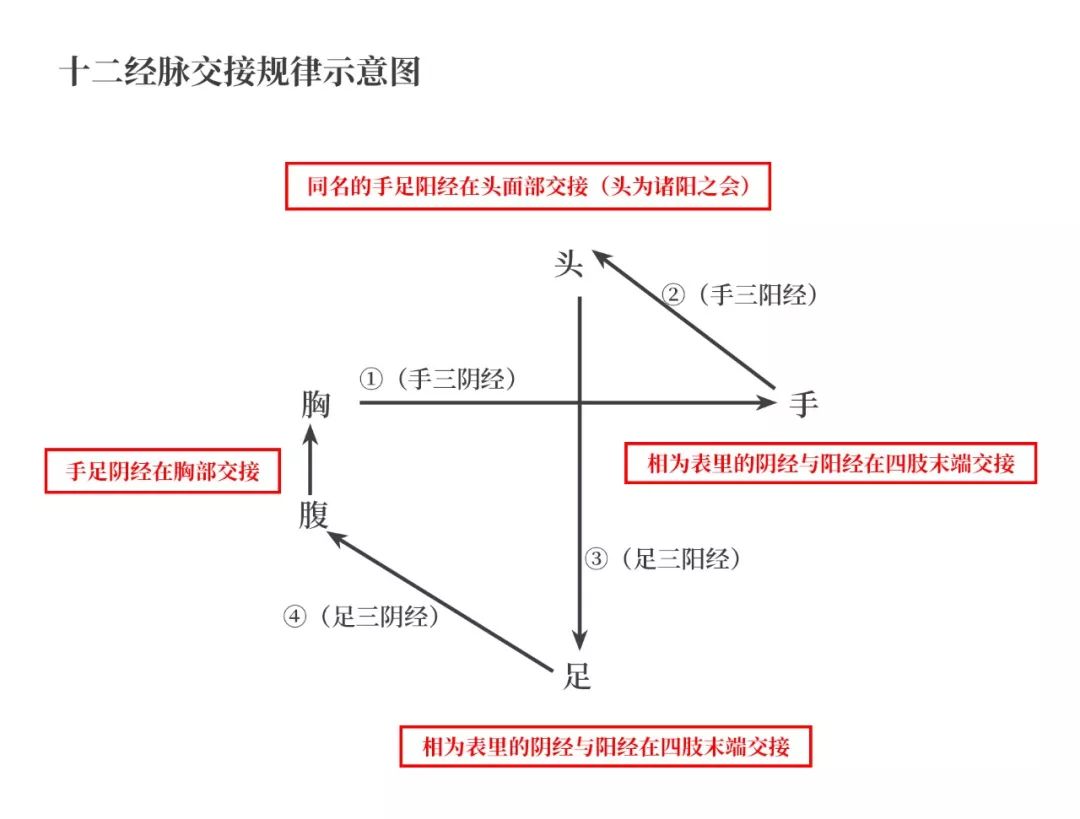
“
The Twelve Meridians Form a Large Closed Loop
”
The rules of interconnection of the twelve meridians described above form a general principle. As for how the twelve meridians are linked together to form a closed loop in the body, we need to analyze it further.
It should be noted that this section provides a detailed illustration and textual explanation of the pathways of the twelve meridians, which may give the impression that the meridians are difficult to learn, resembling a spider web that is hard to untangle, with many obscure terms that are not understood! However, there is no need to worry, as the interconnections of the twelve meridians follow the rules of interconnection mentioned above. If you find the descriptions of each meridian below difficult to understand, there are two solutions: one is to listen to Lao Miao explain it in detail tonight at the Xiang Tai Ji Learning Hall, and the second is to simply remember the content of the twelve small headings below based on understanding, as they summarize how the twelve meridians interconnect to form a large closed loop.
1. The Taiyin Lung Meridian (Shou Taiyin Fei Jing) runs along the inner side of the upper limb, connecting at the tip of the index finger with the Yangming Large Intestine Meridian (Shou Yangming Da Chang Jing).
The Taiyin Lung Meridian originates from the Middle Jiao (Zhongfu), descends to connect with the Large Intestine, then returns along the stomach’s upper opening, passes through the diaphragm, and enters the lungs. From the lung system (trachea, throat) it travels outward to the axilla, descends along the inner side of the upper arm, following the path of the Shaoyin and Jueyin meridians, down to the elbow, along the inner side of the forearm to the radial and ulnar sides, reaching the pulse point at the wrist, and extending to the tip of the thumb (Shao Shang). Its branch emerges from the back of the wrist, traveling along the radial side of the index finger to the tip of the index finger.
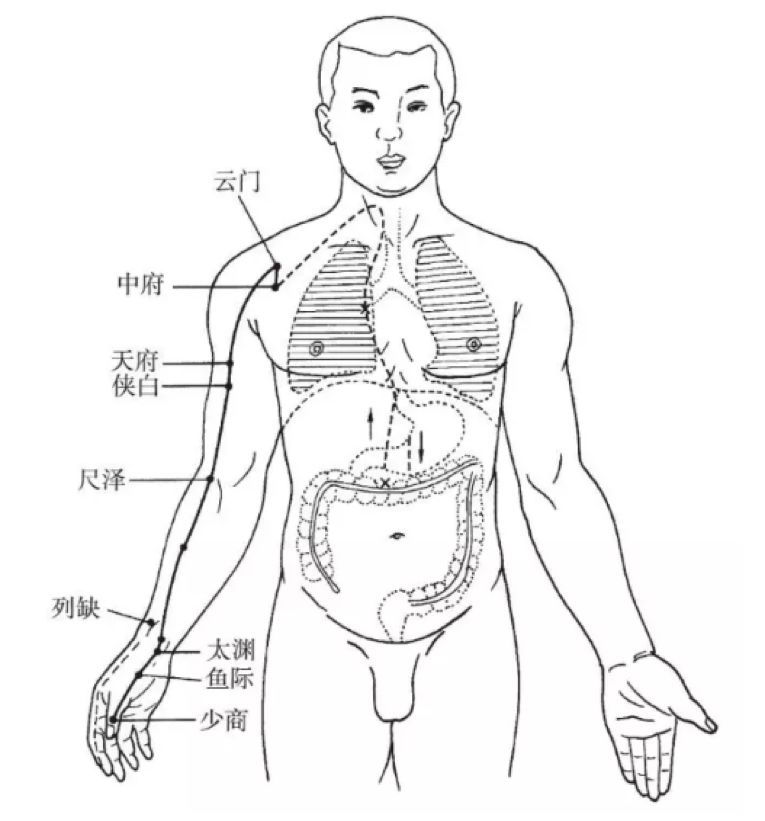
Taiyin Lung Meridian (LU)
2. The Yangming Large Intestine Meridian (Shou Yangming Da Chang Jing) runs along the outer side of the arm, reaching the opposite side of the face near the nostril, connecting with the Yangming Stomach Meridian (Zu Yangming Wei Jing).
The Yangming Large Intestine Meridian originates from the tip of the index finger (Shang Yang) (radial side), travels along the radial side of the index finger, passes between the first and second metacarpals, ascends between the two tendons at the wrist, along the outer side of the forearm, to the outer side of the elbow, then ascends along the outer side of the upper arm to the shoulder, passing in front of the shoulder peak, continuing upward to the back, where it intersects with the Yang meridians at the Dazhui point, then moves forward into the chest, connecting with the lungs, descends through the diaphragm, and belongs to the Large Intestine. Its branch ascends from the chest to the neck, enters the lower teeth, and returns through the corner of the mouth to the upper lip, meeting at the Ren Zhong (Shui Gou) point, with the left and right channels crossing to the opposite nostril (Ying Xiang).
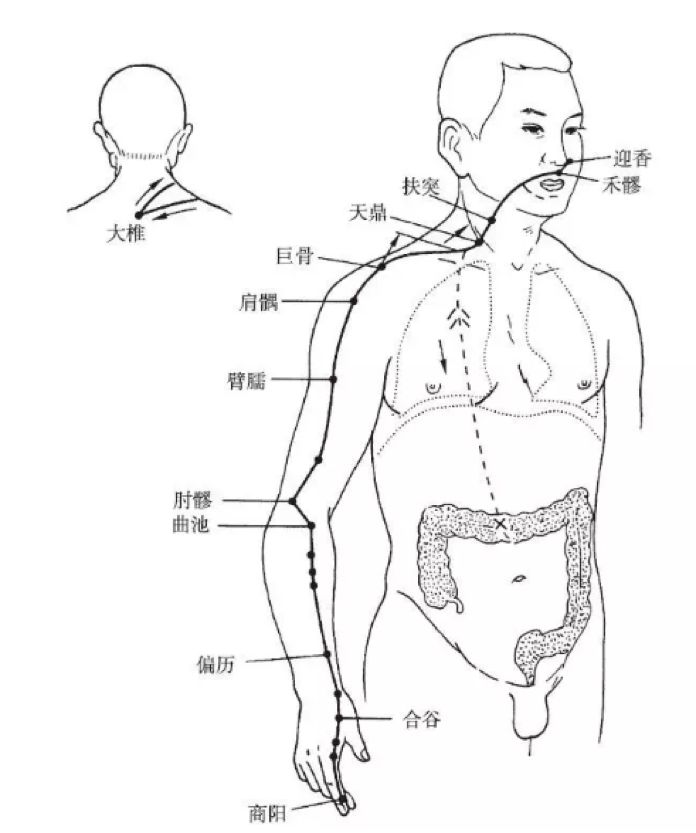 Yangming Large Intestine Meridian (LI)
Yangming Large Intestine Meridian (LI)
3. The Yangming Stomach Meridian (Zu Yangming Wei Jing) descends to connect with the Taiyin Spleen Meridian (Zu Taiyin Pi Jing) at the tip of the toes.
The Yangming Stomach Meridian originates from beside the nose (Cheng Qi), ascends to the root of the nose, intersects with the Taiyang meridian, then descends along the outer side of the nose, enters the upper gum, returns to encircle the lips, and meets at the Cheng Jiang point; it then travels backward along the lower jaw, reaching the Da Ying point, and continues along the jawline to the cheek, ascending to the front of the ear, passing the upper Guan point of the Shaoyang meridian, and along the hairline to the forehead. Its branch descends from the Da Ying point to the Ren Ying point, entering the throat, passing through the diaphragm, belonging to the stomach, and connecting with the spleen. The direct pathway descends from the chest along the inner side of the breast, passing beside the navel to the lower abdomen; one branch diverges from the stomach, descending to the Qi Chong point, where it meets the direct pathway. From there, it descends through the Bi Guan and Fu Tu points to the knee joint. It continues down the outer side of the tibia, reaching the dorsum of the foot to the outer side of the second toe (Li Dui); one branch diverges from three cun below the knee, descending to the outer side of the middle toe; another branch diverges from the dorsum of the foot, traveling along the inner side of the big toe to the tip.
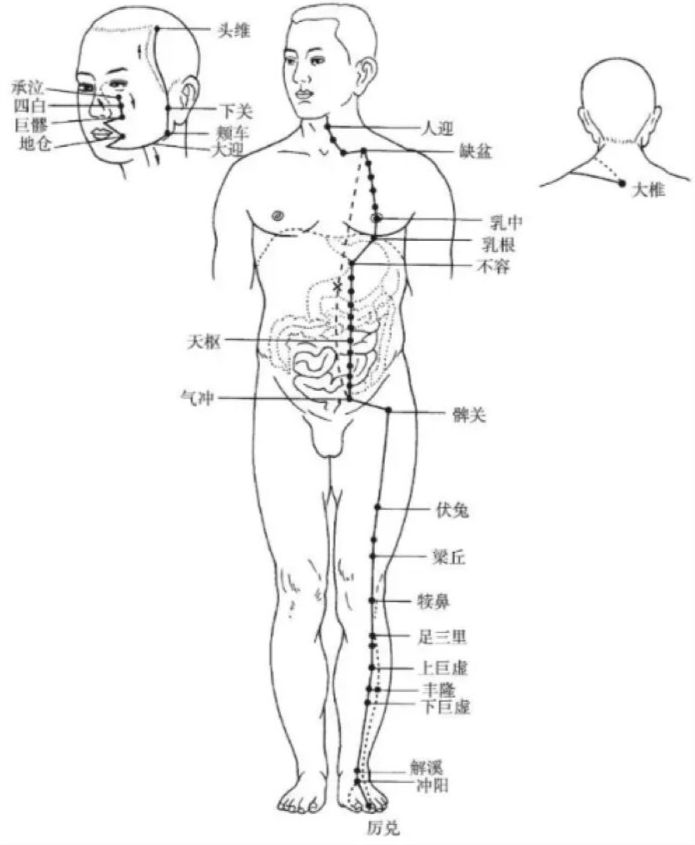 Yangming Stomach Meridian (ST)
Yangming Stomach Meridian (ST)
4. The Taiyin Spleen Meridian (Zu Taiyin Pi Jing) ascends to the heart, connecting with the Shaoyin Heart Meridian (Shou Shaoyin Xin Jing).
The Taiyin Spleen Meridian originates from the tip of the big toe (Yin Bai), travels along the inner side of the big toe, passes behind the first metatarsophalangeal joint, ascends to the front of the inner ankle, then along the inner side of the tibia, ascending to the inner ankle eight cun above, intersecting with the Jueyin Meridian, and continues along the inner side of the thigh, entering the abdomen, belonging to the spleen, connecting with the stomach; it then ascends through the diaphragm, passing beside the throat, connecting with the root of the tongue, and dispersing under the tongue. Its branch emerges from the stomach above the diaphragm, entering the heart (Da Bao).
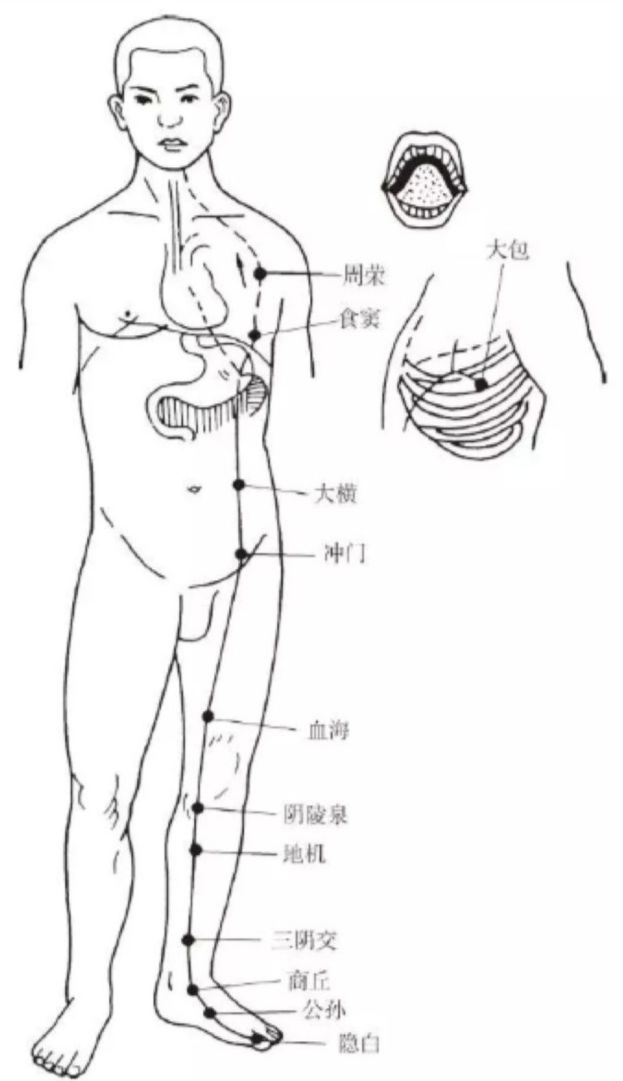
Taiyin Spleen Meridian (SP)
5. The Shaoyin Heart Meridian (Shou Shaoyin Xin Jing) runs along the inner side of the upper limb, connecting at the tip of the little finger with the Taiyang Small Intestine Meridian (Shou Taiyang Xiao Chang Jing).
The Shaoyin Heart Meridian originates from the heart (Ji Quan), belonging to the heart system (the tissues connecting the heart with other organs); it descends through the diaphragm, connecting with the small intestine. Its branch ascends from the heart system, passing alongside the esophagus, connecting with the eye system (the tissues connecting the eyeball with the brain). The direct pathway ascends from the heart system to the lungs, then outward to the axilla, along the inner side of the upper arm, traveling behind the Taiyin and Jueyin meridians, reaching the elbow; it continues along the inner side of the forearm to the pea bone area, entering the palm, and terminating at the radial side of the little finger (Shao Chong).
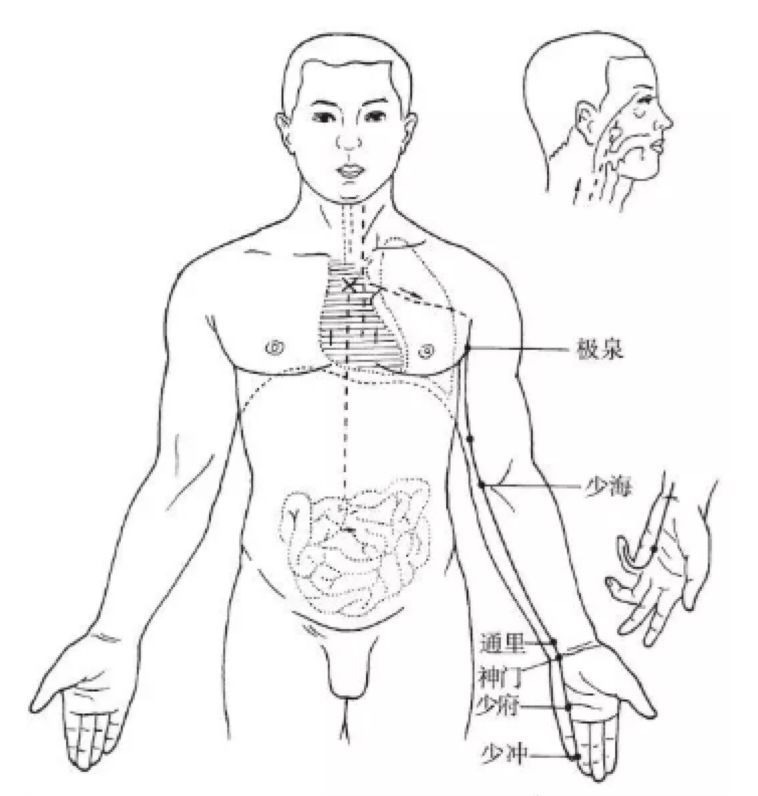 Shaoyin Heart Meridian (HT)
Shaoyin Heart Meridian (HT)
6. The Taiyang Small Intestine Meridian (Shou Taiyang Xiao Chang Jing) runs along the outer side of the upper limb, connecting at the inner canthus of the eye with the Taiyang Bladder Meridian (Zu Taiyang Pang Guang Jing).
The Taiyang Small Intestine Meridian originates from the ulnar side of the little finger (Shao Ze), travels along the outer side of the hand to the wrist, emerging from the ulnar styloid, ascending along the outer side of the forearm, passing between the ulnar and humeral epicondyles, along the outer side of the upper arm to the shoulder, circling around the shoulder blade, intersecting at the Dazhui point, descending into the chest, connecting with the heart, passing through the esophagus, and reaching the stomach, belonging to the small intestine. Its branch diverges from the chest, ascending along the neck, reaching the cheek, entering the inner canthus of the eye, and another branch diverges from the cheek, ascending beneath the eye socket, reaching beside the nose, and connecting at the inner canthus of the eye, intersecting at the zygomatic area (Ting Gong).
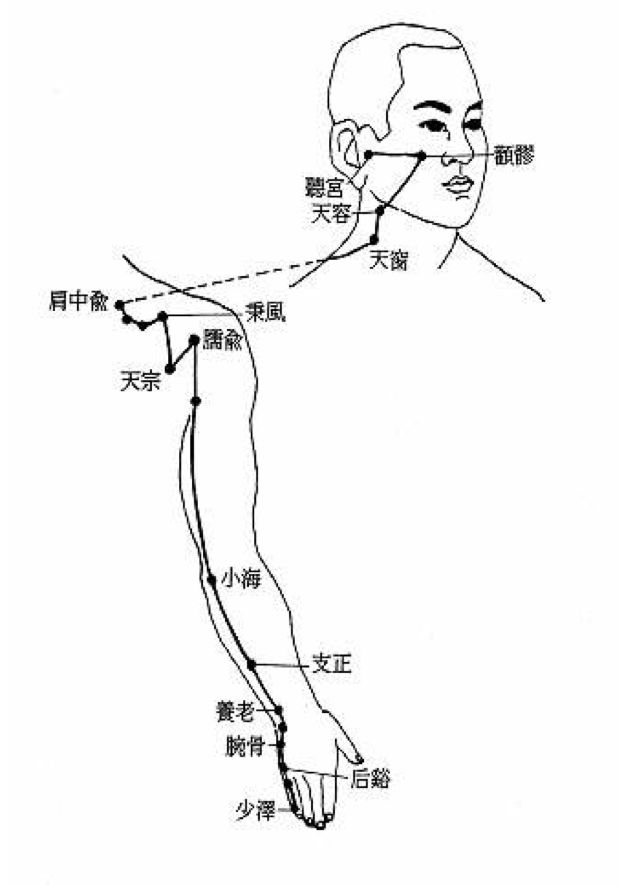 Taiyang Small Intestine Meridian (SI)
Taiyang Small Intestine Meridian (SI)
7. The Taiyang Bladder Meridian (Zu Taiyang Pang Guang Jing) descends to connect with the Shaoyin Kidney Meridian (Zu Shaoyin Shen Jing) at the tip of the little toe.
The Taiyang Bladder Meridian originates from the inner canthus of the eye (Jing Ming), ascends over the forehead, intersecting with the Governing Vessel at the top of the head. Its branch diverges from the top of the head to the upper corner of the ear. The direct pathway enters the skull, connecting with the brain, then descends along the back of the neck, traveling down the sides of the spine to the lumbar region, entering the muscles beside the spine, connecting with the kidneys, belonging to the bladder. One branch diverges from the waist, descending along the sides of the spine, passing through the buttocks, entering the popliteal fossa; another branch descends from the inner sides of the shoulders, passing through the muscles beside the spine, through the hip joint, along the outer side of the thigh, converging in the popliteal fossa, descending through the gastrocnemius muscle, emerging behind the outer ankle, along the fifth metatarsal, reaching the outer side of the little toe (Zhi Yin).
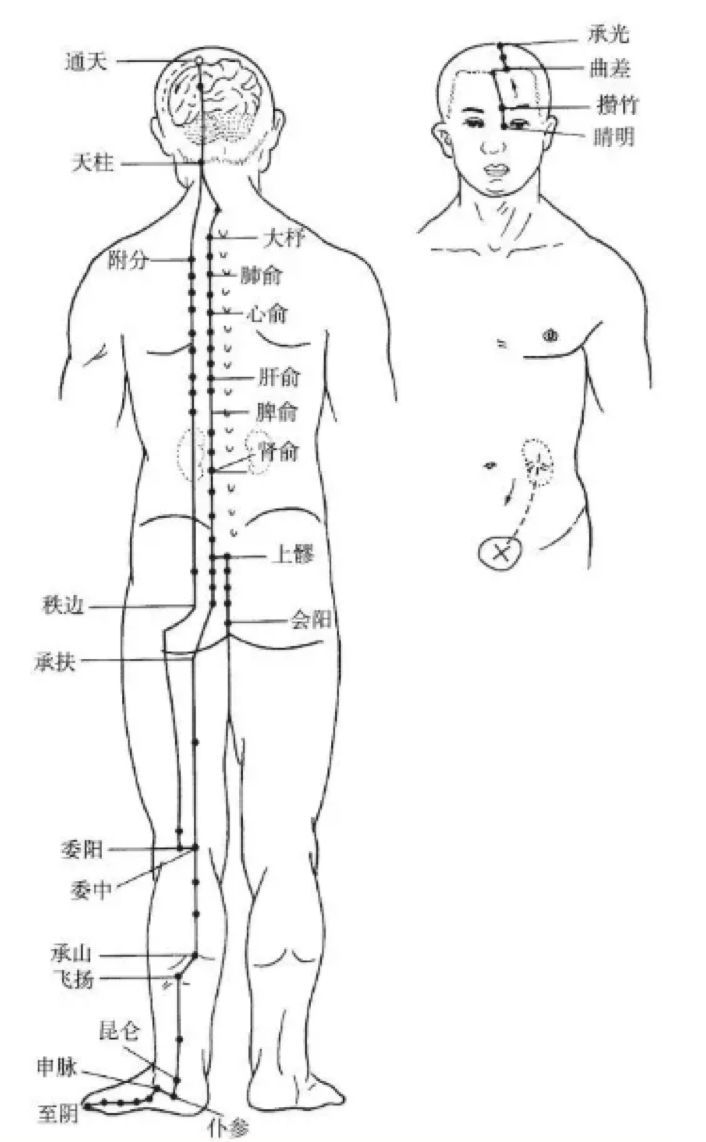 Taiyang Bladder Meridian (BL)
Taiyang Bladder Meridian (BL)
8. The Shaoyin Kidney Meridian (Zu Shaoyin Shen Jing) ascends to the heart and lungs, connecting with the Jueyin Pericardium Meridian (Shou Jueyin Xin Bao Jing).
The Shaoyin Kidney Meridian originates from the sole of the little toe (Yong Quan), traveling diagonally across the sole, passing beneath the tuberosity of the navicular bone, behind the inner ankle, descending into the heel, ascending along the inner side of the leg, passing through the inner side of the popliteal fossa, along the inner side of the thigh, penetrating the spine, belonging to the kidneys, connecting with the bladder (with acupoints also emerging from the front, ascending along the midline of the abdomen 0.5 cun beside the anterior midline, and 2 cun beside the anterior midline of the chest, terminating at the lower edge of the clavicle at the Yu Fu point (Huang Yu)). Its direct branch ascends from the kidneys, passing through the liver and diaphragm, entering the lungs, along the throat, and beside the root of the tongue; another branch diverges from the lungs, connecting with the heart, flowing into the chest.
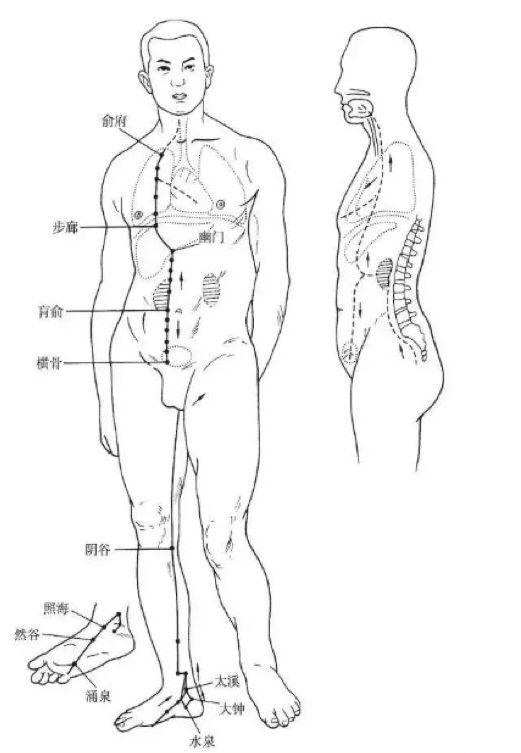 Shaoyin Kidney Meridian (KI)
Shaoyin Kidney Meridian (KI)
9. The Jueyin Pericardium Meridian (Shou Jueyin Xin Bao Jing) runs along the inner side of the upper limb, connecting at the tip of the ring finger with the Shaoyang Sanjiao Meridian (Shou Shaoyang San Jiao Jing).
The Jueyin Pericardium Meridian originates from the chest (Tian Chi), belonging to the pericardium, descending through the diaphragm from the chest to the abdomen, connecting with the upper, middle, and lower Jiao. Its branch travels outward from the chest, reaching three cun below the axilla, then ascends to the axilla, descending along the inner side of the upper arm between the Taiyin and Shaoyin meridians, entering the elbow, then descending to the forearm, traveling between the two tendons, entering the palm, and reaching the tip of the middle finger (Zhong Chong). One branch diverges from the palm, traveling along the ring finger to the tip.
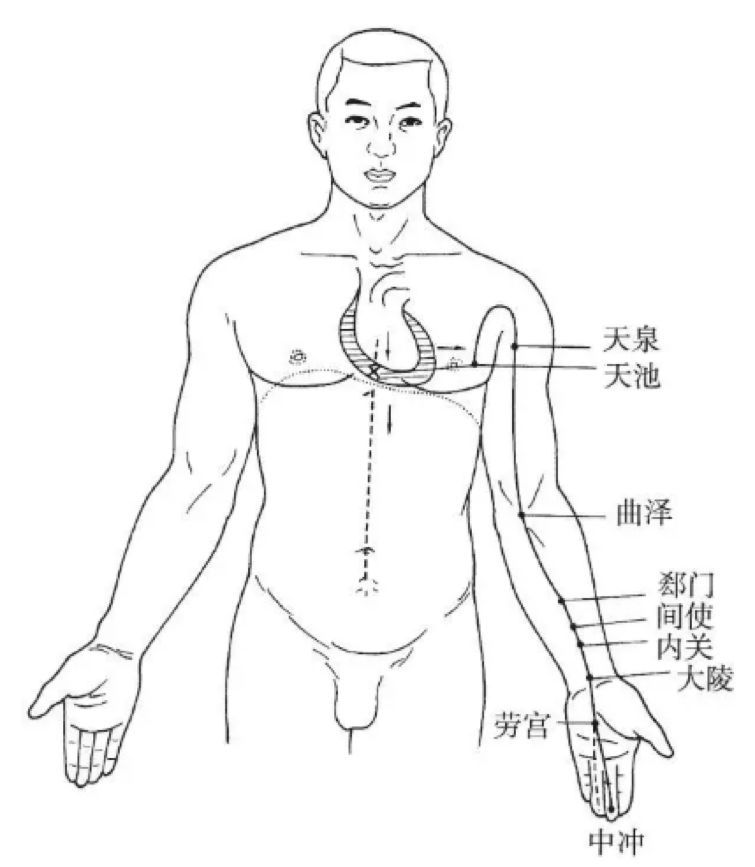 Jueyin Pericardium Meridian (PC)
Jueyin Pericardium Meridian (PC)
10. The Shaoyang Sanjiao Meridian (Shou Shaoyang San Jiao Jing) runs along the outer side of the upper limb, connecting at the outer canthus of the eye with the Shaoyang Gallbladder Meridian (Zu Shaoyang Dan Jing).
The Shaoyang Sanjiao Meridian originates from the ulnar side of the ring finger (Guan Chong), ascending between the little and ring fingers, along the back of the wrist, reaching the outer side of the forearm, traveling between the radius and ulna, passing the elbow, ascending along the outer side of the upper arm to the shoulder, entering the chest, distributing in the heart, and connecting with the upper, middle, and lower Jiao. Its branch diverges from the chest, ascending along the neck, passing behind the ear, descending to the cheek, reaching the lower part of the eye socket (Si Zhu Kong). Another branch diverges from behind the ear, entering the ear, then emerging in front of the ear, traveling along the upper Guan point, reaching the cheek to the outer canthus of the eye.
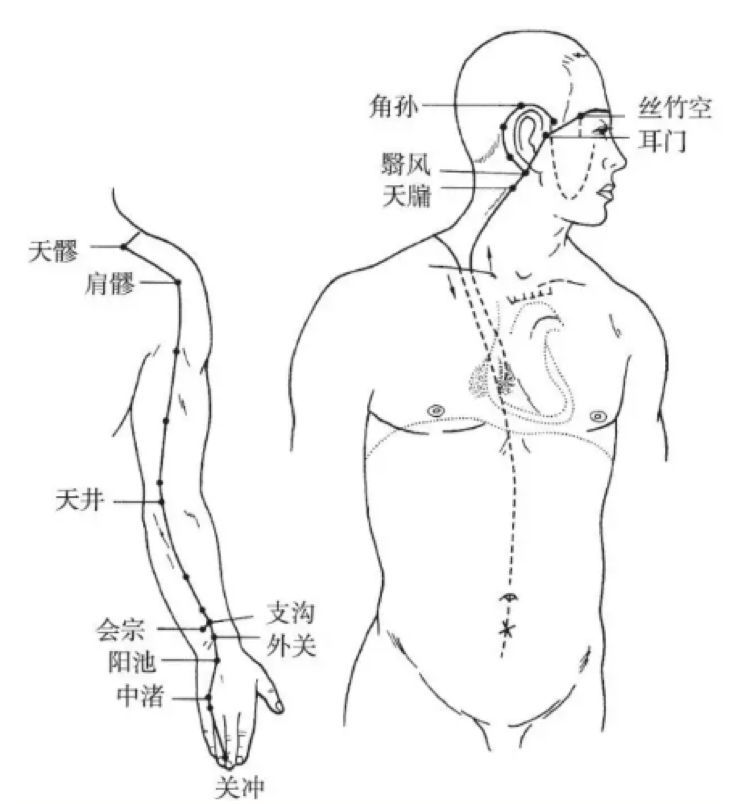 Shaoyang Sanjiao Meridian (TE)
Shaoyang Sanjiao Meridian (TE)
11. The Shaoyang Gallbladder Meridian (Zu Shaoyang Dan Jing) descends to connect with the Jueyin Liver Meridian (Zu Jueyin Gan Jing) at the back of the big toe.
The Shaoyang Gallbladder Meridian originates from the outer canthus of the eye (Tong Zi Liao), ascending to the forehead, descending behind the ear, along the neck to the shoulder, entering the chest. Its branch diverges from behind the ear, entering the ear, emerging in front of the ear, traveling behind the outer canthus. The branch from the outer canthus descends to the Da Ying point, connecting with the Shaoyang meridian to reach the lower part of the eye socket, traveling through the cheek, descending along the neck, and connecting with the liver, belonging to the gallbladder, then descending along the ribs to the groin area, passing through the external genitalia. The direct pathway descends from the chest, passing through the axilla, along the side of the chest, descending to meet the front pathway at the hip joint, then descending along the outer side of the thigh, along the outer edge of the knee, passing in front of the fibula, reaching the front of the outer ankle, along the dorsum of the foot, terminating at the outer side of the fourth toe (Zu Qiao Yin). The branch from the dorsum of the foot diverges, traveling between the first and second metatarsals, emerging at the tip of the big toe, passing through the toenail, and emerging at the dorsum of the foot.
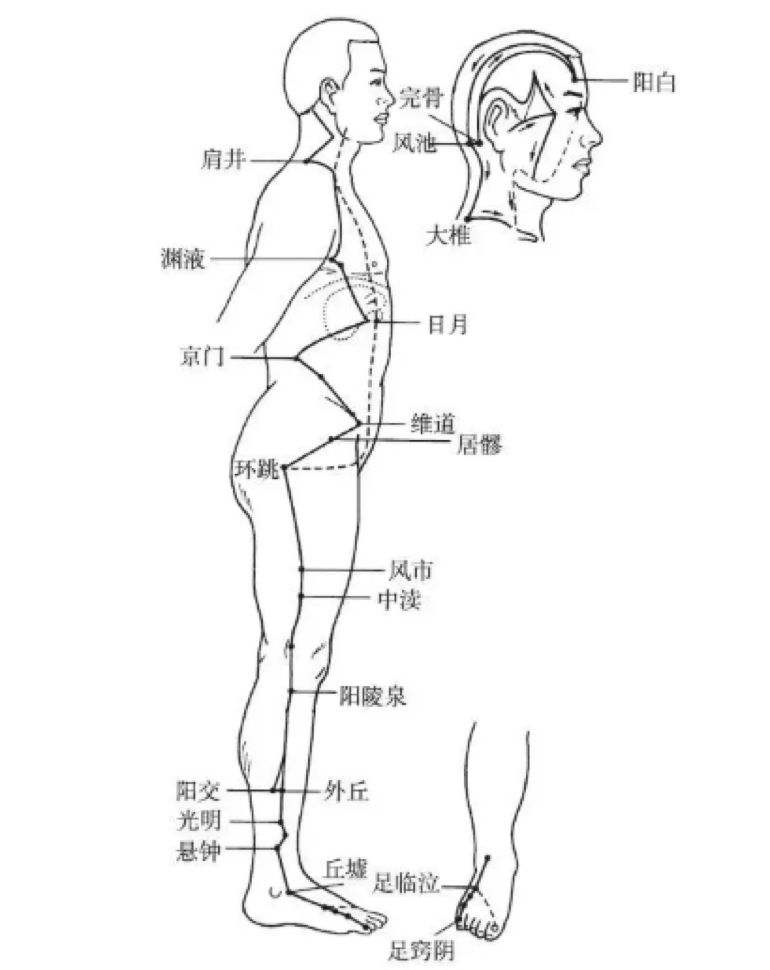 Shaoyang Gallbladder Meridian (GB)
Shaoyang Gallbladder Meridian (GB)
12. The Jueyin Liver Meridian (Zu Jueyin Gan Jing) ascends to the lungs, connecting with the Taiyin Lung Meridian (Shou Taiyin Fei Jing).
The Jueyin Liver Meridian originates from the back of the big toe (Da Dun), traveling along the dorsum of the foot, ascending in front of the inner ankle, intersecting with the Taiyin Meridian eight cun above the inner ankle, continuing along the inner side of the popliteal fossa, along the inner side of the thigh, entering the pubic area, surrounding the genitalia; it then ascends to the lower abdomen, connecting with the stomach, belonging to the liver, connecting with the gallbladder; it ascends through the diaphragm, distributing in the ribs (Qi Men); continuing upward behind the throat, entering the nasopharynx, connecting with the eye system, emerging at the forehead, intersecting with the Governing Vessel at the top of the head. Its branch descends from the eye system, traveling along the cheek, surrounding the lips. Another branch diverges from the liver, passing through the diaphragm, connecting with the lungs.
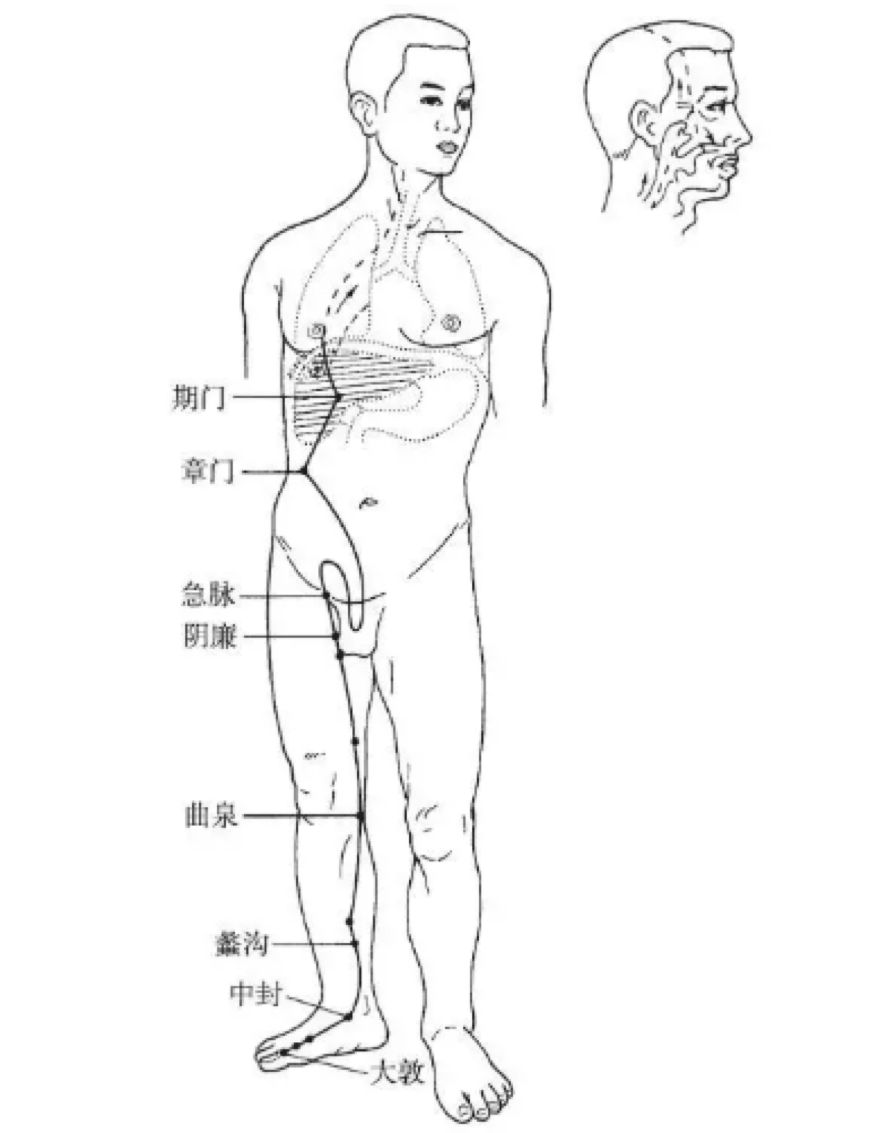 Jueyin Liver Meridian (LR)
Jueyin Liver Meridian (LR)
The twelve meridians, according to the rules of interconnection, form a closed loop in the human body as illustrated in the diagram below.
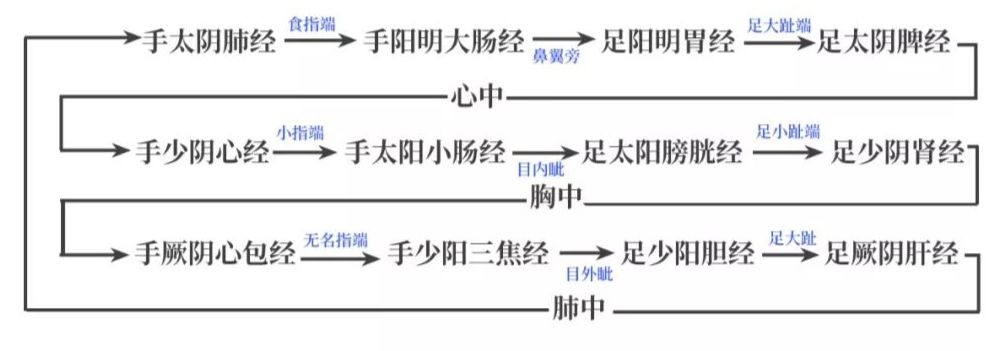
From the diagram of the pathways of the twelve meridians above, we can also observe a pattern: “the foot meridians connect with the hand meridians, with more connections at the feet and fewer at the hands.”
For example, the Taiyin connects with the lesser Yin, which has less Yin energy than the Taiyin, so the Taiyin connects with the Shaoyin; the Shaoyin connects with the Jueyin, which has even less Yin energy, so the Shaoyin Kidney Meridian connects with the Jueyin Pericardium Meridian; the Jueyin connects with the Taiyin Lung Meridian, which has the most Yin energy, as there is no lesser Yin than the Jueyin. Thus, the Jueyin connects with the Taiyin. If we express this in numbers, it can be represented as “three, two, one, three.” That is, the foot three Yin connects with the hand two Yin, the foot two Yin connects with the hand one Yin, and the foot one Yin connects with the hand three Yin, which is the pattern of three connecting to two, two connecting to one, and one connecting to three. This is the interconnection pattern of three, two, one, three. The above is a further understanding and analysis of the interconnection rules of the twelve meridians, which I hope everyone can comprehend for easier memorization.
Related Articles:
It is difficult for folk TCM practitioners to obtain certification!
Examining the challenges faced by TCM through the lens of folk practitioner assessments!
The best general practitioners are TCM practitioners, with a bright future ahead!
TCM should completely abolish the “Physician Qualification Certificate” and switch to clinical examinations!
While the world embraces TCM treatment, China still imposes restrictions on TCM!
Instead of regulating “illegal medical practice,” it is better to fully open up!
To achieve free healthcare in China, TCM is essential!
Using Western medicine for cancer treatment is fatal; TCM should be used in this way!


